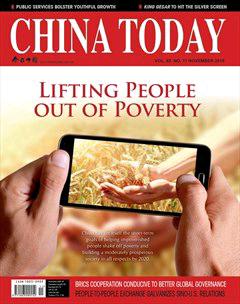Voices
Voices

“Terrorism is the common enemy of humankind. Enhanced counterterrorism cooperation between China and India is in the interest of both peoples. I hope the two sides adopt an open and active attitude, deepen the consensus we have reached, and work out the specifics so that our cooperation will turn into solid actions, effectively safeguarding the security and stability of both countries and the region as well.”
Meng Jianzhu, a member of the Political Bureau of the CPC Central Committee and secretary of the Commission for Political and Legal Affairs under the CPC Central Committee, told the Indian delegation headed by R.N. Ravi, chairman of the Joint Intelligence Committee, who came to Beijing for the first China-India Dialogue on Counterterrorism and Security held on September 27.

“China actively supports the sustainable development of developing countries. In September last year, when attending the summits commemorating the 70th Anniversary of the founding of the United Nations, President Xi Jinping announced a series of major initiatives, including setting up the China-UN Peace and Development Fund. The Fund will kick off its operational projects this year. The Institute of South-South Cooperation and Development was inaugurated in April 2016 and began enrolling students…China has already launched“Six 100 Projects” designed to support developing countries in such fields as poverty reduction, agriculture, biological conservation, medi-care, environmental protection, and education. The Assistance Fund for South-South Cooperation, tasked with assisting developing countries in their efforts to implement the 2030 Agenda, is also expected to be up and running soon.”
Xu Bu, Chinese ambassador to ASEAN, delivered a speech entitled“China and ASEAN Should Stay Firmly Focused on Cooperation on Sustainable Development” on September 19, in Jakarta.
The Great Wall and North China: Past and Present

Life WeekIssue No. 40, 2016
Construction of the Great Wall peaked in the Ming Dynasty (1368-1644), when around 6,300 kilometers of the wall, stretching from east to west, was built.
The two sides of the Great Wall, according to Owen Lattimore, respectively represent the nomadic and farming civilizations. Characterized by mobility, warriors on horseback embodied the nomadic culture. For farmers, in complete contrast, the accent was on accumulation of wealth, often represented by finely cultivated farmland on plains adjacent to rivers or lakes, where cities developed. Nevertheless, the two cultures were never absolutely opposed or disparate. Their border formed by the Great Wall was a transitional zone of prairie and oases that enabled forest and grassland dwellers to merge. Meanwhile, agricultural and pastoral economies coexisted in this area. Regional disputes or conflicts across the Great Wall in the lead-up to the Industrial Revolution, to put it one way, were usually triggered by commerce. Looking at these piles of bricks on steep mountains, we can clearly grasp the gap between the two cultures in the minds of ancient peoples. It was a deep fear of “barbarians” that drove the agrarian society to overcome all obstacles in efforts to construct a long line of defense. On the other hand, nomads on the other side of the wall rode over mountains to ram the gate of agrarian society, driven by their growing demands for trade.
The area has been accessible by railway since the beginning of the 20th century. A novelty on both sides of the Great Wall, railways represented a deeper Western influence – mercantile trade advanced to direct investment of foreign capital.
Today, areas around the Great Wall are covered by extensive road networks that have introduced new capitals which have changed economic patterns beyond the wall. Nomads no longer need to fight for the sake of commerce as they have become participants in international trade. For instance, Nestlé has set up an office in Inner Mongolia so as to be closer to grassland and cattle. At the same time, local herdsmen take part directly in the world dairy trade. Industries, services, and migrants are flooding areas beyond the Great Wall, which unavoidably drains land resources. The nomadic economy is thus losing its feature of mobility as pastures shrink.
This seems to be the trend as the modern world develops. In today’s society, nomads are faced with two possibilities: to change –by jumping into a totally alien world; or vanish, like Native Americans, whose culture was unable to survive in a new era. As for the area beyond the Great Wall, it is becoming a land that has surrendered to the Industrial Revolution, rather than a place where nomadic and farming cultures collide.

